- Home
- Carl Sagan
The Dragons of Eden Page 2
The Dragons of Eden Read online
Page 2
Part of the enjoyment and indeed delight of this subject is its contact with all areas of human endeavor, particularly with the possible interaction between insights obtained from brain physiology and insights obtained from human introspection. There is, fortunately, a long history of the latter, and in former times the richest, most intricate and most profound of these were called myths. “Myths,” declared Salustius in the fourth century, “are things which never happened but always are.” In the Platonic dialogues and The Republic, every time Socrates cranks up a myth—the parable of the cave, to take the most celebrated example—we know that we have arrived at something central.
I am not here employing the word “myth” in its present popular meaning of something widely believed and contrary to fact, but rather in its earlier sense, as a metaphor of some subtlety on a subject difficult to describe in any other way. Accordingly, I have interspersed in the discussion on the following pages occasional excursions into myths, ancient and modern. The title of the book itself comes from the unexpected aptness of several different myths, traditional and contemporary.
While I hope that some of my conclusions may be of interest to those whose profession is the study of human intelligence, I have written this book for the interested layman. Chapter 2 presents arguments of somewhat greater difficulty than the rest of this inquiry, but still, I hope, accessible with only a little effort. Thereafter, the book should be smooth sailing. Occasional technical terms are usually defined when first introduced, and are collected in the glossary. The figures and the glossary are additional tools to aid those with no formal background in science, although understanding my arguments and agreeing with them are not, I suspect, the same thing.
In 1754, Jean Jacques Rousseau, in the opening paragraph of his Dissertation on the Origin and Foundation of the Inequity of Mankind, wrote:
Important as it may be, in order to judge rightly of the natural state of man, to consider him from his origin … I shall not follow his organization through its successive developments.… On this subject I could form none but vague and almost imaginary conjectures. Comparative anatomy has as yet made too little progress, and the observations of naturalists are too uncertain to afford an adequate basis for any solid reasoning.
Rousseau’s cautions of more than two centuries ago are valid still. But there has been remarkable progress in investigating both comparative brain anatomy and animal and human behavior, which he correctly recognized as critical to the problem. It may not be premature today to attempt a preliminary synthesis.
* Since the time of the famous Victorian debate between Bishop Wilberforce and T. H. Huxley, there has been a steady and notably unproductive barrage fired against the Darwin/Wallace ideas, often by those with doctrinal axes to grind. Evolution is a fact amply demonstrated by the fossil record and by contemporary molecular biology. Natural selection is a successful theory devised to explain the fact of evolution. For a very polite response to recent criticisms of natural selection, including the quaint view that it is a tautology (“Those who survive survive”), see the article by Gould (1976) listed in the references at the back of this book. Darwin was, of course, a man of his times and occasionally given—as in his remarks on the inhabitants of Tierra del Fuego quoted above—to self-congratulatory comparisons of Europeans with other peoples. In fact, human society in pretechnological times was much more like that of the compassionate, communal and cultured Bushman hunter-gatherers of the Kalahari Desert than the Fuegians Darwin, with some justification, derided. But the Darwinian insights—on the existence of evolution, on natural selection as its prime cause, and on the relevance of these concepts to the nature of human beings—are landmarks in the history of human inquiry, the more so because of the dogged resistance which such ideas evoked in Victorian England, as, to a lesser extent, they still do today.
1
THE
COSMIC
CALENDAR
What seest thou else
In the dark backward and abysm of time?
WM. SHAKESPEARE
The Tempest
HE WORLD is very old, and human beings are very young. Significant events in our personal lives are measured in years or less; our lifetimes in decades; our family genealogies in centuries; and all of recorded history in millennia. But we have been preceded by an awesome vista of time, extending for prodigious periods into the past, about which we know little—both because there are no written records and because we have real difficulty in grasping the immensity of the intervals involved.
Yet we are able to date events in the remote past. Geological stratification and radioactive dating provide information on archaeological, palenotological and geological events; and astrophysical theory provides data on the ages of planetary surfaces, stars, and the Milky Way Galaxy, as well as an estimate of the time that has elapsed since that extraordinary event called the Big Bang—an explosion that involved all of the matter and energy in the present universe. The Big Bang may be the beginning of the universe, or it may be a discontinuity in which information about the earlier history of the universe was destroyed. But it is certainly the earliest event about which we have any record.
The most instructive way I know to express this cosmic chronology is to imagine the fifteen-billion-year lifetime of the universe (or at least its present incarnation since the Big Bang) compressed into the span of a single year. Then every billion years of Earth history would correspond to about twenty-four days of our cosmic year, and one second of that year to 475 real revolutions of the Earth about the sun. On this page through this page I present the cosmic chronology in three forms: a list of some representative pre-December dates; a calendar for the month of December; and a closer look at the late evening of New Year’s Eve. On this scale, the events of our history books—even books that make significant efforts to deprovincialize the present—are so compressed that it is necessary to give a second-by-second recounting of the last seconds of the cosmic year. Even then, we find events listed as contemporary that we have been taught to consider as widely separated in time. In the history of life, an equally rich tapestry must have been woven in other periods—for example, between 10:02 and 10:03 on the morning of April 6th or September 16th. But we have detailed records only for the very end of the cosmic year.
The chronology corresponds to the best evidence now available. But some of it is rather shaky. No one would be astounded if, for example, it turns out that plants colonized the land in the Ordovician rather than the Silurian Period; or that segmented worms appeared earlier in the Precambrian Period than indicated. Also, in the chronology of the last ten seconds of the cosmic year, it was obviously impossible for me to include all significant events; I hope I may be excused for not having explicitly mentioned advances in art, music and literature or the historically significant American, French, Russian and Chinese revolutions.
PRE-DECEMBER DATES
Big Bang January 1
Origin of the Milky Way Galaxy May 1
Origin of the solar system September 9
Formation of the Earth September 14
Origin of life on Earth September 25
Formation of the oldest rocks known on Earth October 2
Date of oldest fossils (bacteria and blue-green algae) October 9
Invention of sex (by microorganisms) ~November 1
Oldest fossil photosynthetic plants November 12
Eukaryotes (first cells with nuclei) flourish November 15
~ = approximately
DECEMBER 31
Origin of Proconsul and Ramapithecus, probable ancestors of apes and men ~1:30 P.M.
First humans ~10:30 P.M.
Widespread use of stone tools 11:00 P.M.
Domestication of fire by Peking man 11:46 P.M.
Beginning of most recent glacial period 11:56 P.M.
Seafarers settle Australia 11:58 P.M.
Extensive cave painting in Europe 11:59 P.M.
Invention of agriculture 11:59:20 P.M.
/> Neolithic civilization; first cities 11:59:35 P.M.
First dynasties in Sumer, Ebla and Egypt; development of astronomy 11:59:50 P.M.
Invention of the alphabet; Akkadian Empire 11:59:51 P.M.
Hammurabic legal codes in Babylon; Middle Kingdom in Egypt 11:59:52 P.M.
Bronze metallurgy; Mycenaean culture; Trojan War; Olmec culture: invention of the compass 11:59:53 P.M.
Iron metallurgy; First Assyrian Empire; Kingdom of Israel; founding of Carthage by Phoenicia 11:59:54 P.M.
Asokan India; Ch’in Dynasty China; Periclean Athens; birth of Buddha 11:59:55 P.M.
Euclidean geometry; Archimedean physics; Ptolemaic astronomy; Roman Empire; birth of Christ 11:59:56 P.M.
Zero and decimals invented in Indian arithmetic; Rome falls; Moslem conquests 11:59:57 P.M.
Mayan civilization; Sung Dynasty China; Byzantine empire; Mongol invasion; Crusades 11:59:58 P.M.
Renaissance in Europe; voyages of discovery from Europe and from Ming Dynasty China; emergence of the experimental method in science 11:59:59 P.M.
Widespread development of science and technology; emergence of a global culture; acquisition of the means for self-destruction of the human species; first steps in spacecraft planetary exploration and the search for extraterrestrial intelligence Now:
The first second of New Year’s Day
The construction of such tables and calendars is inevitably humbling. It is disconcerting to find that in such a cosmic year the Earth does not condense out of interstellar matter until early September; dinosaurs emerge on Christmas Eve; flowers arise on December 28th; and men and women originate at 10:30 P.M. on New Year’s Eve. All of recorded history occupies the last ten seconds of December 31; and the time from the waning of the Middle Ages to the present occupies little more than one second. But because I have arranged it that way, the first cosmic year has just ended. And despite the insignificance of the instant we have so far occupied in cosmic time, it is clear that what happens on and near Earth at the beginning of the second cosmic year will depend very much on the scientific wisdom and the distinctly human sensitivity of mankind.
2
GENES
AND
BRAINS
What the hammer? What the chain?
In what furnace was thy brain?
What the anvil? What dread grasp
Dare its deadly terrors clasp?
WM. BLAKE
“The Tyger”
Of all animals, man has the largest brain in proportion to his size.
ARISTOTLE
The Parts of Animals
IOLOGICAL evolution has been accompanied by increasing complexity. The most complex organisms on Earth today contain substantially more stored information, both genetic and extragenetic, than the most complex organisms of, say, two hundred million years ago—which is only 5 percent of the history of life on the planet, five days ago on the Cosmic Calendar. The simplest organisms on Earth today have just as much evolutionary history behind them as the most complex, and it may well be that the internal biochemistry of contemporary bacteria is more efficient than the internal biochemistry of the bacteria of three billion years ago. But the amount of genetic information in bacteria today is probably not vastly greater than that in their ancient bacterial ancestors. It is important to distinguish between the amount of information and the quality of that information.
The various biological forms are called taxa (singular, taxon). The largest taxonomic divisions distinguish between plants and animals, or between those organisms with poorly developed nuclei in their cells (such as bacteria and blue-green algae) and those with very clearly demarcated and elaborately architectured nuclei (such as protozoa or people). All organisms on the planet Earth, however, whether they have well-defined nuclei or not, have chromosomes, which contain the genetic material passed on from generation to generation. In all organisms the hereditary molecules are nucleic acids. With a few unimportant exceptions, the hereditary nucleic acid is always the molecule called DNA (deoxyribonucleic acid). Much finer divisions among various sorts of plants and animals, down to species, subspecies and races, can also be described as separate taxa.
A species is a group that can produce fertile offspring by crosses within but not outside itself. The mating of different breeds of dogs yields puppies which, when grown, will be reproductively competent dogs. But crosses between species—even species as similar as donkeys and horses—produce infertile offspring (in this case, mules). Donkeys and horses are therefore categorized as separate species. Viable but infertile matings of more widely separated species—for example, lions and tigers—sometimes occur, and if, rarely, the offspring are fertile, this indicates only that the definition of species is a little fuzzy. All human beings are members of the same species, Homo sapiens, which means, in optimistic Latin, “Man, the wise.” Our probable ancestors, Homo erectus and Homo habilis—now extinct—are classified as of the same genus (Homo) but of different species, although no one (at least lately) has attempted the appropriate experiments to see if crosses of them with us would produce fertile offspring.
In earlier times it was widely held that offspring could be produced by crosses between extremely different organisms. The Minotaur whom Theseus slew was said to be the result of a mating between a bull and a woman. And the Roman historian Pliny suggested that the ostrich, then newly discovered, was the result of a cross between a giraffe and a gnat. (It would, I suppose, have to be a female giraffe and a male gnat.) In practice there must be many such crosses which have not been attempted because of a certain understandable lack of motivation.
The chart that appears on this page will be referred to repeatedly in this chapter. The solid curve on it shows the times of earliest emergence of various major taxa. Many more taxa exist, of course, than are shown by the few points in the figure. But the curve is representative of the much denser array of points that would be necessary to characterize the tens of millions of separate taxa which have emerged during the history of life on our planet. The major taxa, which have evolved most recently, are by and large the most complicated.
Some notion of the complexity of an organism can be obtained merely by considering its behavior—that is, the number of different functions it is called upon to perform in its lifetime. But complexity can also be judged by the minimum information content in the organism’s genetic material. A typical human chromosome has one very long DNA molecule wound into coils, so that the space it occupies is very much smaller than it would be if it were unraveled. This DNA molecule is composed of smaller building blocks, a little like the rungs and sides of a rope ladder. These blocks are called nucleotides and come in four varieties. The language of life, our hereditary information, is determined by the sequence of the four different sorts of nucleotides. We might say that the language of heredity is written in an alphabet of only four letters.
But the book of life is very rich; a typical chromosomal DNA molecule in a human being is composed of about five billion pairs of nucleotides. The genetic instructions of all the other taxa on Earth are written in the same language, with the same code book. Indeed, this shared genetic language is one line of evidence that all the organisms on Earth are descended from a single ancestor, a single instance of the origin of life some four billion years ago.
The information content of any message is usually described in units called bits, which is short for “binary digits.” The simplest arithmetical scheme uses not ten digits (as we do because of the evolutionary accident that we have ten fingers) but only two, 0 and 1. Thus any sufficiently crisp question can be answered by a single binary digit—0 or 1, yes or no. If the genetic code were written in a language of two letters rather than four letters, the number of bits in a DNA molecule would equal twice the number of nucleotide pairs. But since there are four different kinds of nucleotides, the number of bits of information in DNA is four times the number of nucleotide pairs. Thus if a single chromosome has five billion (5 × 109) nucleotide
s, it contains twenty billion (2 × 1010) bits of information. [A symbol such as 109 merely indicates a one followed by a certain number of zeroes—in this case, nine of them.]
How much information is twenty billion bits? What would be its equivalent, if it were written down in an ordinary printed book in a modern human language? Alphabetical human languages characteristically have twenty to forty letters plus one or two dozen numerals and punctuation marks; thus sixty-four alternative characters should suffice for most such languages. Since 26 equals 64 (2 × 2 × 2 × 2 × 2 × 2), it should take no more than six bits to specify a given character. We can think of this being done by a sort of game of “Twenty Questions,” in which each answer corresponds to the investment of a single bit to a yes/no question. Suppose the character in question is the letter J. We might specify it by the following procedure:
FIRST QUESTION: Is it a letter (0) or some other character (1)?

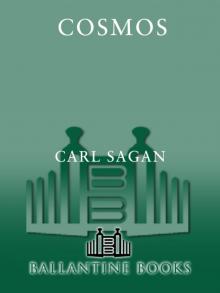 Cosmos
Cosmos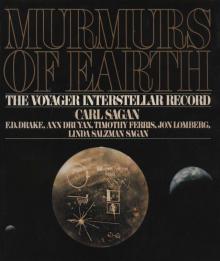 Murmurs of Earth
Murmurs of Earth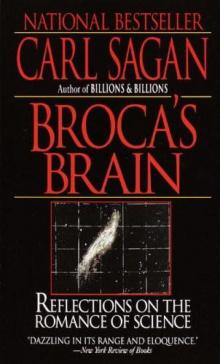 Broca's Brain
Broca's Brain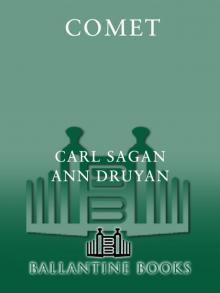 Comet
Comet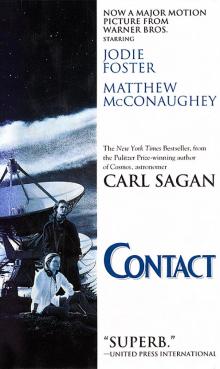 Contact
Contact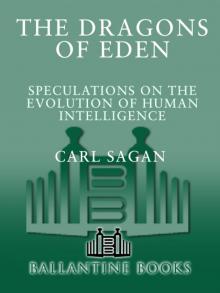 Dragons of Eden
Dragons of Eden Cosmic Connection
Cosmic Connection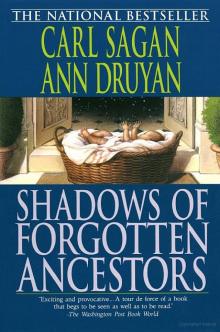 Shadows of Forgotten Ancestors
Shadows of Forgotten Ancestors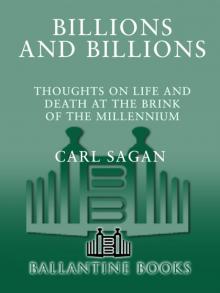 Billions & Billions
Billions & Billions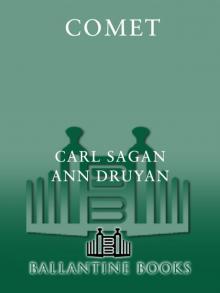 Comet, Revised
Comet, Revised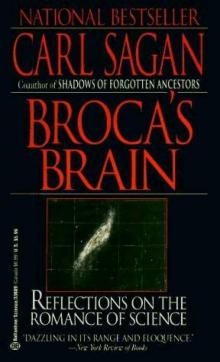 Broca's Brain: The Romance of Science
Broca's Brain: The Romance of Science The Varieties of Scientific Experience: A Personal View of the Search for God
The Varieties of Scientific Experience: A Personal View of the Search for God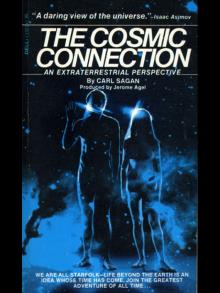 The Cosmic Connection
The Cosmic Connection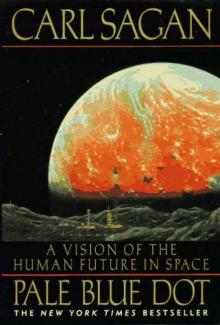 Pale Blue Dot: A Vision of the Human Future in Space
Pale Blue Dot: A Vision of the Human Future in Space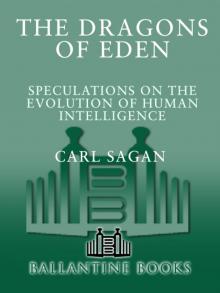 The Dragons of Eden
The Dragons of Eden